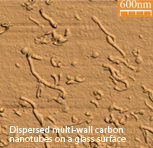Home > Press > Making the most of carbon nanotube-liquid crystal combos: Physical response of combination materials made of nanotubes with ferroelectric liquid crystals could lead to new applications
 |
Abstract:
Dispersions of carbon nanotubes with liquid crystals have attracted much interest because they pave the way for creating new materials with added functionalities. Now, a study published in EPJ E by Marina Yakemseva and colleagues at the Nanomaterials Research Institute in Ivanovo, Russia, focuses on the influence of temperature and nanotube concentration on the physical properties of such combined materials. These findings could have implications for optimising these combinations for non-display applications, such as sensors or externally stimulated switches, and novel materials that are responsive to electric, magnetic, mechanical or even optical fields.
Making the most of carbon nanotube-liquid crystal combos: Physical response of combination materials made of nanotubes with ferroelectric liquid crystals could lead to new applications
Heidelberg, Germany and New York, NY | Posted on April 2nd, 2014The added functionalities of these compound materials are achieved by combining the self-organisation of a liquid crystal with the characteristics of nanotubes, which exhibit a major difference in electric and thermal conductivity between their long and short axis. In this study, the authors focused on the electro-optic and dielectric properties of ferroelectric liquid crystal-multiwall carbon nanotube combinations.
Specifically, they studied the influence of temperature on the compound material's main physical properties, such as tilt angle, spontaneous polarisation, response time, viscosity, and the strength and frequency of its dielectric relaxation. They found that all dispersions exhibit the expected temperature dependencies with regard to their physical properties.
They also investigated the dependence of physical characteristics on nanotube concentration, which is still the subject of several contradicting reports. For increasing nanotube concentration, they observed a decrease in tilt angle, but an increase in spontaneous polarisation. This phenomenon explains the enhancement of the so-called bilinear coupling coefficient between tilt angle and spontaneous polarisation. Despite the increase in polarisation, the electro-optic response times slow down, which suggests an increase in rotational viscosity along the tilt cone. This phenomenon also accounts for the observed decrease in dielectric relaxation frequency for increasing nanotube concentration.
####
For more information, please click here
Contacts:
Saskia Rohmer
Springer
Corporate Communications
tel +49 6221 4878414
Copyright © Springer
If you have a comment, please Contact us.Issuers of news releases, not 7th Wave, Inc. or Nanotechnology Now, are solely responsible for the accuracy of the content.
| Related Links |
| Related News Press |
News and information
![]() Researchers develop molecular qubits that communicate at telecom frequencies October 3rd, 2025
Researchers develop molecular qubits that communicate at telecom frequencies October 3rd, 2025
![]() Next-generation quantum communication October 3rd, 2025
Next-generation quantum communication October 3rd, 2025
![]() "Nanoreactor" cage uses visible light for catalytic and ultra-selective cross-cycloadditions October 3rd, 2025
"Nanoreactor" cage uses visible light for catalytic and ultra-selective cross-cycloadditions October 3rd, 2025
Display technology/LEDs/SS Lighting/OLEDs
![]() Spinel-type sulfide semiconductors to operate the next-generation LEDs and solar cells For solar-cell absorbers and green-LED source October 3rd, 2025
Spinel-type sulfide semiconductors to operate the next-generation LEDs and solar cells For solar-cell absorbers and green-LED source October 3rd, 2025
Nanotubes/Buckyballs/Fullerenes/Nanorods/Nanostrings
![]() Enhancing power factor of p- and n-type single-walled carbon nanotubes April 25th, 2025
Enhancing power factor of p- and n-type single-walled carbon nanotubes April 25th, 2025
![]() Chainmail-like material could be the future of armor: First 2D mechanically interlocked polymer exhibits exceptional flexibility and strength January 17th, 2025
Chainmail-like material could be the future of armor: First 2D mechanically interlocked polymer exhibits exceptional flexibility and strength January 17th, 2025
![]() Innovative biomimetic superhydrophobic coating combines repair and buffering properties for superior anti-erosion December 13th, 2024
Innovative biomimetic superhydrophobic coating combines repair and buffering properties for superior anti-erosion December 13th, 2024
Sensors
![]() Sensors innovations for smart lithium-based batteries: advancements, opportunities, and potential challenges August 8th, 2025
Sensors innovations for smart lithium-based batteries: advancements, opportunities, and potential challenges August 8th, 2025
![]() Quantum engineers ‘squeeze’ laser frequency combs to make more sensitive gas sensors January 17th, 2025
Quantum engineers ‘squeeze’ laser frequency combs to make more sensitive gas sensors January 17th, 2025
Discoveries
![]() Researchers develop molecular qubits that communicate at telecom frequencies October 3rd, 2025
Researchers develop molecular qubits that communicate at telecom frequencies October 3rd, 2025
![]() Next-generation quantum communication October 3rd, 2025
Next-generation quantum communication October 3rd, 2025
![]() "Nanoreactor" cage uses visible light for catalytic and ultra-selective cross-cycloadditions October 3rd, 2025
"Nanoreactor" cage uses visible light for catalytic and ultra-selective cross-cycloadditions October 3rd, 2025
Announcements
![]() Rice membrane extracts lithium from brines with greater speed, less waste October 3rd, 2025
Rice membrane extracts lithium from brines with greater speed, less waste October 3rd, 2025
![]() Researchers develop molecular qubits that communicate at telecom frequencies October 3rd, 2025
Researchers develop molecular qubits that communicate at telecom frequencies October 3rd, 2025
![]() Next-generation quantum communication October 3rd, 2025
Next-generation quantum communication October 3rd, 2025
![]() "Nanoreactor" cage uses visible light for catalytic and ultra-selective cross-cycloadditions October 3rd, 2025
"Nanoreactor" cage uses visible light for catalytic and ultra-selective cross-cycloadditions October 3rd, 2025
Interviews/Book Reviews/Essays/Reports/Podcasts/Journals/White papers/Posters
![]() Spinel-type sulfide semiconductors to operate the next-generation LEDs and solar cells For solar-cell absorbers and green-LED source October 3rd, 2025
Spinel-type sulfide semiconductors to operate the next-generation LEDs and solar cells For solar-cell absorbers and green-LED source October 3rd, 2025
![]() Rice membrane extracts lithium from brines with greater speed, less waste October 3rd, 2025
Rice membrane extracts lithium from brines with greater speed, less waste October 3rd, 2025
|
|
||
|
|
||
| The latest news from around the world, FREE | ||
|
|
||
|
|
||
| Premium Products | ||
|
|
||
|
Only the news you want to read!
Learn More |
||
|
|
||
|
Full-service, expert consulting
Learn More |
||
|
|
||








